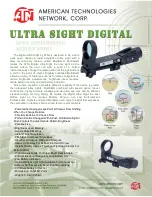
7
cal tube in front of the focuser. Both the 8" and 10" models
have added length in front of the focuser, compared to a stan-
dard Newtonian, to prevent any possibility of incoming light
from impinging directly on the secondary mirror or entering
the focuser drawtube. The baffle rings and the interior of the
optical tube are both painted flat black to further absorb stray
light. These enhancements ensure the best possible contrast
when observing and photographing faint celestial objects.
Visual Observing with the f/3.9 Newtonian
Astrograph
The 8" and 10" f/3.9 Newtonian Astrographs are optimized
for photographic imaging, but they can also be used of visual
observing of ccelestial objects. (Because the field of view in a
Newtonian reflector is rotated from right-side-up, this type of
telescope is not recommended for terrestrial observing.) The
tall 1.25" eyepiece holder adapter that comes installed in the
focuser from the factory should allow you to achieve focus
with most 1.25" telescope eyepieces
(Figure 7).
For 2" eyepieces, you will likely have to use a 2" extension
adapter to achieve focus with a 2" eyepiece. Two such adapt-
ers are included with your telescope
(Figure 7). One is a
thread-on adapter that adds 30mm of extension, the other is
a slip-in adapter that adds 36mm of extension. You may need
one or the other adapter depending on the amount of exten-
sion required for your eyepiece.
To install the thread-on 2" extension, first remove the 2"
accessory collar on the focuser drawtube by turning it coun-
terclockwise until it comes off. Then thread the 2" extension
adapter onto the focuser drawtube until tight. Insert a 2" eye-
piece into the extension adapter and secure with the two
thumbscrews. To install the slip-in 2" extension adapter, just
insert its tapered base into the 2" accessory collar of the fo-
cuser, then tighten the two locking thumbscrews to secure the
adapter in place.
Collimating the Optics (Aligning the Mirrors)
Collimating is the process of adjusting the mirrors so they are
aligned with one another. Precise collimation of the optics is
especially critical for fast Newtonian optics such as in the f/3.9
astrographs. If the mirrors are even slightly misaligned, image
quality will suffer. So you should check the collimation before
every observing or imaging session, to make sure it is dead-
on. The process of collimation is a relatively easy and can be
done in daylight or darkness.
Your telescope’s optics were collimated at the factory, and
should not need much adjustment unless the telescope was
handled roughly in transit. To check collimation, remove the
eyepiece and look down the focuser drawtube. You should
see the secondary mirror centered in the drawtube, as well
as the reflection of the primary mirror centered in the sec-
ondary mirror, and the reflection of the secondary mirror (and
your eye) centered in the reflection of the primary mirror, as in
Figure 8a. If anything is off-center, proceed with the following
collimating procedure.
Figure 8.
Collimating the optics.
(a) When the mirrors are properly aligned, the view down the focuser drawtube should look like this. (b)
With the collimation cap in place, if the optics are out of alignment, the view might look something like this.
(c) Here, the secondary mirror is
centered under the focuser, but it needs to be adjusted (tilted) so that the entire primary mirror is visible.
(d) The secondary mirror is correctly
aligned, but the primary mirror still needs adjustment. When the primary mirror is correctly aligned, the center “dot” of the collimation cap will
be centered, as in
(e).
drawtube
Reflection
of primary
mirror clip
Primary mirror
center mark
Reflective surface
of collimation
cap
a.
b.
c.
d.
e.



















